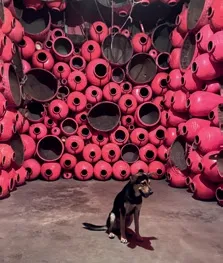All-inclusive Rural Revitalization
2022-11-04ByDariaLisaia
By Daria Lisaia
Solving the three rural issues—the development of agriculture, the rural areas and farmers—is a top priority for the Communist Party of China (CPC). In his address to the Central Rural Work Conference on December 28, 2020, Chinese President Xi Jinping stressed the need to mobilize the whole Party and society to promote rural revitalization.
The political discourse on rural revitalization has become a reference point for Chinese society.Many large companies, universities, professional organizations and associations, architects, designers, artists and other members of society have all responded to the government’s call. Here are two inspirational cases of village revival under this approach: Huangling Village and Hanxi Village in Jiangxi Province.
Huangling in Jiangxi’s Wuyuan County is one of the ancient villages featuring the unique Huizhou-style architecture. It is considered one of the most beautiful villages in China. About 500 years ago, locals moved from neighboring Anhui Province’s Huizhou region to the mountainous area of Wuyuan,establishing their new home on a steep mountainside. Fast forward to the 20th century, the village’s development faced many obstacles. In 2009, the local government decided to build a new village at the base of the mountain along the highway and relocate the 320 residents of the ancient village. That same year,Wuyuan Huangling Cultural Tourism Co. Ltd. was founded, implementing the project through its own investments and becoming the village’s management company. The total built-up area of the new settlement is 15,047 square meters.At present, Huangling comprises both the new village at the base of the mountain and the original ancient village. The resettlement of people from the remote mountainous area has reduced the threat of hidden geological hazards to local life and property and significantly raised living standards.

A dog sitting inside Hanxi Village’s Memory Containers art space on September 17
The project preserved and revealed the authentic features of local tangible and intangible heritage. Tourists can take in the atmosphere of rural life and experience how the village navigates its own course into the future.
Hanxi in Fuliang County, then, is located some 20 km from Jingdezhen City,also known as China’s porcelain capital,surrounded by beautiful slopes of black tea farms.
In July 2020, local authorities invited a Beijing-based exhibition program to investigate new art movements and cultural events, which conducted a series of studies and offered to host a curatorial exhibition titled Art at Fuliang 2021, a contemporary art festival. As part of the festival, the concept of village revitalization took shape by attracting artists, hosting art events,and developing rural cultural tourism.
Art at Fuliang 2021 is a regional arts project that promotes a locality that includes telling local stories, using local materials and local resources, and engaging locals. Taking off in January 2021, the project’s management team has invited several wellknown artists and architects who,inspired by the history of the village and its surrounding landscape, have created many diverse artworks channeling the area’s unique assets.
These two cases are just a small sample of what China is doing to continue improving the living standards of all people, whether in the cities or the countryside. The participation of both state and society is a must to preserve the identity of the villages, their culture and traditions. BR
